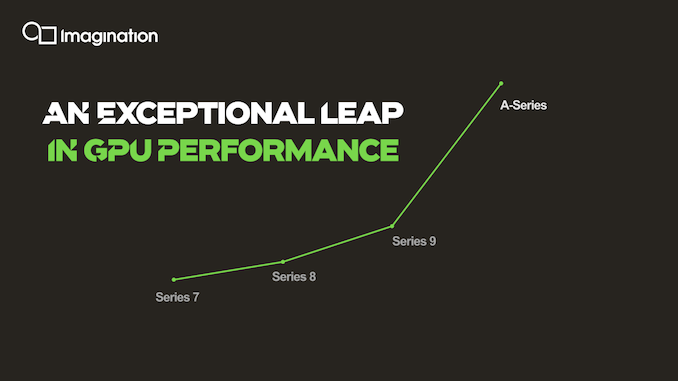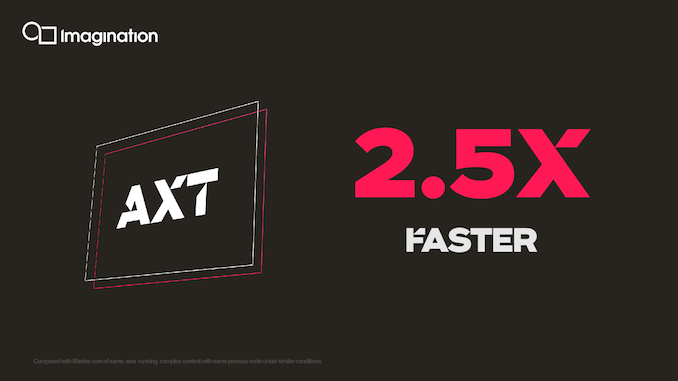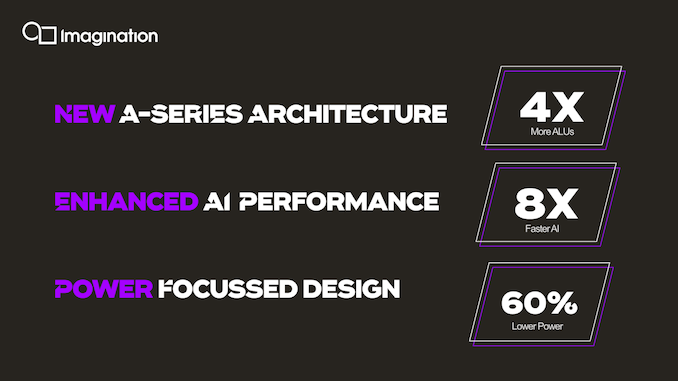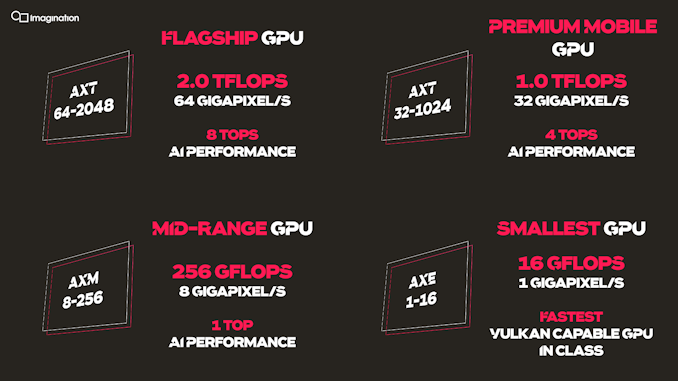Imagination Announces A-Series GPU Architecture: "Most Important Launch in 15 Years"
by Andrei Frumusanu on December 2, 2019 8:00 PM EST
There are very few companies in the world able to claim a history in the graphics market dating back to the “golden age” of the 90’s. Among the handful of survivors of that era are of course NVIDIA and AMD (formerly ATI), but there is also Imagination Technologies. The company has been around since the early days of graphics accelerators and has seen a shifting industry. In the early to mid-2000’s the company moved away from the desktop space, instead focusing on offering GPU IP optimized for mobile devices.
The Mobile GPU IP Market Situation
The mobile GPU IP market these days is a quite barren landscape; Imagination’s long history along with Arm’s rise to a leadership position with the Mali GPUs has essentially created a duopoly, as smaller vendors such as Vivante have exited the market. The problem of duopolies like these is that there’s a risk of stagnation if either vendor falls behind in terms of technology, and most of the time this comes at the cost of the vendors who rely on licensing the IP.
Over the last several years in particular, we’ve seen a larger shift in the mobile market dynamics as Qualcomm has increasingly managed to dominate over its competitors. The more vertically integrated company produces its own SoC designs using its own in-house GPU IP, and as a result isn’t reliant on technologies from Imagination or Arm (CPUs are a whole other story).
More recently, we’ve seen Apple’s custom GPU efforts make huge leaps in performance and efficiency. While officially we have no concrete information on the behind-the-scenes details of Apple’s design, it’s commonly regarded as a design forked-off from Imagination IP back in 2015, which Apple continues to independently develop thanks to an architectural license. The relationship between Apple and Imagination nowadays is still quite unclear, but the frictions from back in 2017, which ultimately lead to Imagination putting itself to sale and being bought by an equity firm with Chinese investors, seem to have calmed down.
The more important situation to consider is that the two leading GPUs in the mobile market today – Apple and Qualcomm – are designs that are internally developed by the SoC vendors themselves. This is a bit troubling for everybody else in the market, as their reliance on IP licensing means they’re limited in what they’re able to do. MediaTek had suffered quite a lot in terms of market share versus Qualcomm for example (GPU being only one of many other reasons). Other vendors such as Samsung have evidently also realized their situation, and launched development of their own internal GPU architectures, with a more recent surprise development of actually licensing new GPU IP from AMD in order to compete with Apple’s designs.
Introducing Imagination's new A-Series: "Fastest GPU IP ever created"
With that quite long foreword and context in mind, we come full circle to Imagination as well as today’s announcement. Today, the company is revealing its new A-Series GPU IP, describing the new product as Imagination’s most important GPU and IP launch in 15 years. The wording here is extremely strong, and the goals of the new product seem pretty clear: reverse the trend of market share loss against custom GPUs in the market, and put licensed GPU IP back at the forefront of performance.
A-Series is the company’s 10th generation GPU architecture and represents a big leap for the company. Even something simple, like the product names, have changed. Gone is the longstanding PowerVR branding, in favor of a more immediate focus on Imagination the company. We'll still see PowerVR around – Imagination is keeping it to describe their technology, particularly their tile-based deferred rendering approach – but after over 20 years it's no longer a brand in and of itself.
As a note on the new GPU IP naming scheme: it’s a deliberate departure from the numerical numbering of the past, and instead is trying to represent a new clean start going forward. I asked, but unfortunately the name it isn’t meant to be a clever twist on a “Series 10” with the numbering now represented in hexadecimal, a pity I say!
The new naming crosses the company’s whole GPU range going from the low-end, mid-range to high-end. Here we see the continuation of the XE, XM and XT suffixes; however as in the past, there are architectural differences between the IPs, with today’s news mostly covering the new XT series.
As mentioned, the new A-Series promises to bring some exceptional leaps in performance compared to past generation designs, although it’s also important to point out some footnotes on the matter.
An important metric that’s been showcased today is Imagination's claim that the new A-series XT design is 2.5x faster. "Fast than what" you might ask? The figure represents the new architecture’s performance leap in an ISO-area and process node comparison against Imagination's previous generation Series 9 GPU.
The thing to note is that the company isn’t doing exact apples-to-apples comparisons between different generations of XT GPUs, but rather is making comparisons to the latest widely available “Series 9” on the market. This was an unfortunate, but yet practical choice to make given that currently there’s no publicly announced or available chips which make use of the company’s 8XT or 9XTP designs.
The comparison data here is likely based on MediaTek’s Helio P90 with the GM9446 – technically part of the 9-series, but also architecturally based on the older Rogue architecture. Imagination wanted to be more transparent in regards to its area and performance claims for the A-Series, and the comparison with the 9XM Rogue-based GPU provides a much more recent and readily available baseline against which vendors can independently verify and compare metrics to.
Key improvements of the A-Series include a massive overhaul over the GPU’s compute units and ALU architecture, promising a 4x increase over a 9XM Rogue GPU. AI is a first-class citizen in the A-Series and we’ll be seeing dedicated compute resources resulting into improvements of up to 8x in performance. Finally, the new architecture is said to bring a very large leap in terms of power efficiency, with the new design consuming 60% less power for a similar level of performance.
The new architecture covered today spans four disclosed configurations in the XT series, as well as one XM configuration. The XE series, while having seen improvements, isn’t based on the new architecture, but rather a continuation from the previous generation.
Imagination’s naming for the new A-Series is extremely straightforward in regards to understanding their positioning a performance. The AXT-64-2048 for example represents the highest end configuration of the architecture in the XT range, achieving 64 texels per clock and 2048 FP32 FLOPs per clock. AI TOP performance is quadruple the FLOPS, so in this case for an envisioned 1GHz design, the AXT-64-2048 reaches 2 TFLOPs in graphics and compute power, 8 TOPs in INT8 inference throughput, and 64 Gigatexel/s fill rate.
It should also be noted that it's more correct to say Gigatexels/s instead of Gigapixels/s as in the marketing materials published - Imagination found that a lot of people didn't correctly grasp the meaning of texture fillrate and thus opted to simplify the marketing information in pixels/s.
The figures scale down the range with corresponding performance with the AXT-48-1536, AXT-32-1024, AXT-16-512 and finally the AXM-8-256. The AXE-1-16 is a separate, smaller more customized microarchitecture.
Imagination envisions the AXT-32-1024 to be the traditional sweet-spot target for a premium mobile GPU SoC in smartphones, while the larger configurations would possibly be used in larger form-factor devices.
The company calls the A-Series “the GPU of everything”, and there’s indeed a ton of changes and features that make up the new IP. We’ll be covering a few aspects of the company’s disclosed big matrix of features above, starting off with one of the biggest changes, the GPU’s ALU architecture.
















143 Comments
View All Comments
The_Assimilator - Tuesday, December 3, 2019 - link
So what you're saying is that this "fastest GPU IP ever created" has theoretical throughput figures that are lower than a two-generation-old midrange desktop parts.Man, it's gonna be exciting when this is released and it's total unmitigated shite, like every mobile GPU ever.
ET - Wednesday, December 4, 2019 - link
For me a more useful comparison point is the consoles. Xbox One S is 1.4 TFLOPS, PS4 is 1.84 TFLOPS, and, more to the point, Switch supposedly reaches 1 TFLOPS for 16 bit at maximum, but in practice, and for 32 bit, it's around 400 GFLOPS (when docked).So in theory the AXT-64-2048 could make for quite a decent low power console chip, and a good upgrade venue for Nintendo.
(Sure, Xbox and PS have moved a little forward since then, and will move more next year, but, as an owner of a One S, I still find it quite impressive what can be achieved with this kind of GPU power.)
mode_13h - Wednesday, December 4, 2019 - link
Nintendo Switch uses the Tegra X1, which was made to be a high-end tablet SoC. So, by extension, it's not surprising that a modern candidate for that application would potentially be a worthy successor for the Switch.Speaking of set top consoles, you're citing 2013-era models (okay, the One S is more recent, but really a small tweak on the original spec). If you instead look at the PS4 Pro and One X, then you'll see that the set top consoles have moved far beyond this GPU.
Lolimaster - Tuesday, December 3, 2019 - link
The just lost it, now even qorse with amd makibg its return to arm socs.melgross - Tuesday, December 3, 2019 - link
Imagination was in trouble for a long time. The reason Apple, and Microsoft before that, left, was because Imagination refused to go along with requests from both companies for custom IP. Apple, for example needed more work on AI and ML. Imagination refused to work on that for them, which was a major mistake, as Apple was half their business, and generating more than half of their profit.When Apple announced they were developing their own GPU, they said that within two years they would no longer be using any Imagination IP. Imagination confirmed that. The assumption there was that older SoCs that Apple would continue to use for other devices would still incorporate the IP until they had been superseded by newer versions.
It’s believed that newer Apple SoCs contain no Imagination IP.
It’s interesting to see that this new Imagination IP seems to be close to what Apple wanted, but what Imagination refused to give them. A fascinating turnabout. Now it remains to be seen whether this serious improvement upon their older IP is really competitive with the newest IP from others, when it actually is in production, assuming it will really be used.
Andrei Frumusanu - Tuesday, December 3, 2019 - link
> When Apple announced they were developing their own GPU, they said that within two years they would no longer be using any Imagination IP. Imagination confirmed that.The only thing Imagination confirmed is that Apple told them that. Ironically all those press releases and all official mentions of this have disappeared from both companies, which is essentially a sign that the two companies burried the hatchets and they came under some form of agreement.
> It’s believed that newer Apple SoCs contain no Imagination IP.
Well no, we're still here two years later. Apple's GPUs still very much look like PowerVR GPUs with similar block structures, they are still using IMG's proprietary TBDR techniques, and even publicly expose proprietary features such as PVRTC. Saying Apple GPUs contain none of IMG's IP is just incompetent on the topic.
melgross - Tuesday, December 3, 2019 - link
Well, I’m going by what Apple themselves have said. So if you think they’re lying, good for you. But I’ll take their statements as fact first.Qasar - Tuesday, December 3, 2019 - link
just like you seem to do with intel ???mode_13h - Wednesday, December 4, 2019 - link
You saw that Andrei worked there 'till 2017, right? So, yeah, go ahead and argue with him. You're obviously the expert, here.Korguz - Wednesday, December 4, 2019 - link
mode_13h, of course he is. he believes all the lies and BS that intel is also saying....